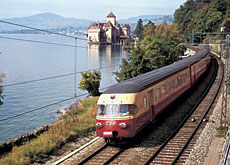Vintage TEE train back on track

When it was first launched in 1961, the electric Trans European Express (TEE) train revolutionised railway travel. More than 40 years on, the sleek railway icon is once again turning heads.
It has been put back into service much to the joy of train buffs and fans of 1960s design.
The Heritage Foundation of the Swiss Federal Railways has restored the RAe TEE II, repainting it in its burgundy and cream livery and reinstating the original fixtures to turn it back into the luxury train that it once was.
The vintage train will now run on special tourist routes in Switzerland.
“Until the Trans European Express service came along, trains had first, second and third class seating,” says the foundation’s Thomas Köppel, “but there was only first class on the TEE trains.”
Köppel says the European railways joined forces to introduce the fast inter-city train service in 1957 because of fears of losing passengers to the growing airline industry, which was increasing its European network.
A step ahead
Luxury seating and fine dining on streamlined trains that had the advantage of being able to stop in city centres were to keep the railways a step ahead of the airlines.
And diesel engines were chosen to pull the first TEE trains to overcome the problem posed by the different electrical currents in use across Europe.
This enabled the trains to cross borders without the costly delays of having to decouple and hook up locomotives.
But diesel engines could only provide a temporary solution because Europe’s railways were busy upgrading and expanding their electric lines.
Engine of change
The Swiss Federal Railways became the engine of change in 1961 when it introduced the RAe TEE II – the first electric train that could run on all four electrical currents.
“We had to construct a rather complicated transformer,” remembers Maurice Borel, the electrical engineer who played a key role in designing the engine. “But it worked and it’s still working today.”
Unlike early steam trains, or the diesel and electric trains of the past or present, the engine of the RAe TEE II was placed in the middle of the composition.
To be more precise, there were four engines- one to run on each of the different currents.
The driver simply had to press a button; the transformer did the rest.
Travel in style
The new train could reach speeds up to 140 kilometres an hour. But passengers who could afford the service not only wanted to reach their destination quickly, they wanted to do so in style.
This fact was not lost on the Swiss Federal Railways who for the first time commissioned a team of architects to create a new-age design.
“The front of the train has a timeless elegance,” says architect Hans-Ulrich Sennhauser, who did his thesis on the design of the TEE train.
“The form was an outer expression of the comforts passengers expected once they boarded the train.”
It was one of the first train compositions with air conditioning, fluorescent lighting and elegant table lamps in the full-service dining carriage and adjoining bar.
A compliment of chefs prepared meals using fresh ingredients. White jacketed waiters set the tables with table clothes and silverware, and uncorked the wine.
Demanding travellers
Even the washrooms were up to the standards of the most demanding travellers of the day.
“It was such a fancy train that it even had a separate women’s washroom, with a big mirror and ample counter space so female passengers could do their makeup,” remarks Köppel.
“It was the only train to ever have that.”
The TEE train was in service until 1989 when it took over some of the new EuroCity routes.
Second class carriages were added and it was repainted silver to distinguish itself from its luxurious predecessor.
However, its days were numbered. After another five years as an inter-city train it was reduced to serving secondary routes until it was finally pulled from the rails in 1999.
swissinfo, Dale Bechtel
European railways introduced the Trans European Express service in 1957.
The Swiss Federal Railways built the first electric train for the service, which could run on all four electrical currents in Europe.
A subsidiary of the Swiss Federal Railways, Railaway (see link), will now run the restored TEE composition on special tourist routes and for charters.
The restored RAe TEE II is a six-carriage composition, with seating for 42 passengers – all in first class.
There is room for a further 48 people in the dining carriage and bar, and another carriage has been transformed into a piano lounge with seating for 36.
The kitchen has been modernised so meals are no longer prepared from scratch using fresh ingredients.
The RAe TEE II is the latest addition to the Heritage Foundation’s fleet of more than two-dozen restored steam, diesel and electric trains.
Some of the trains are on permanent display at the Swiss Transport Museum in Lucerne.
The archive and library of the foundation (SBB Historic) in Bern is open to the public.

In compliance with the JTI standards
More: SWI swissinfo.ch certified by the Journalism Trust Initiative

You can find an overview of ongoing debates with our journalists here. Please join us!
If you want to start a conversation about a topic raised in this article or want to report factual errors, email us at english@swissinfo.ch.